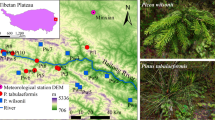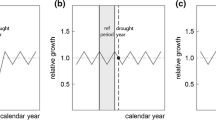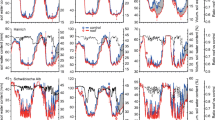Abstract
In recent decades, severe droughts have become an important cause of canopy disturbance in forests, and have shown potential to cause rapid and pronounced vegetation shifts. Under dead canopy, undamaged understory could influence the nature of resource limitation for seedling growth and survival, limiting forest regeneration. We assessed the release response of understory vegetation after a severe drought event in temperate forests of northern Patagonia. Growth trends of dominant tree saplings, and changes in vegetation biodiversity and cover were compared between drought-dead and unaffected canopy. Nothofagus dombeyi undergo growth release after the climatic event in affected forests, and the response was evidenced immediately after the disturbance. For Austrocedrus chilensis, the growth release response was less evident, due mainly to a difference in age structure. In the understory the release response was barely discernable for some components. There was a tendency towards higher cover of the shrub layer in the understory of drought-affected forests, and an important presence of the exotic shrub Rosa rubiginosa. However, the clearest biotic response following drought mortality was the release in growth of understory dominant tree component. Those results strongly suggest that the environment under drought-dead canopy, and the die-off in woody sapling cohorts in a self-thinning process, could favor crown expansion and growth release of understory species that could help predict future forest trajectories in the context of the influence of climatic extreme events.




Similar content being viewed by others
References
Allen CD, Breshears DD (1998) Drought-induced shift of a forest-woodland ecotone: rapid landscape response to climate variation. Proc Natl Acad Sci USA 95:14829–14842
Allen CD, Macalady AK, Chenchouni H, Bachelet D, McDowell N, Vennetier M, Kitzberger T, Rigling A, Breshears DD, Hogg EH, Gonzalez P, Fensham RJ, Zhang Z, Castro J, Demidova N, Lim J, Allard G, Running SW, Semerci A, Cobb NS (2009) A global overview of drought and heat-induced tree mortality reveals emerging climate change risks for forests. For Ecol Manag 4:660–684
Archaux F, Wolters V (2006) Impact of summer drought on forest biodiversity: what do we know? Ann For Sci 63:645–652
Beckage B, Clark JS (2003) Seedling survival and growth of three forest tree species: the role of spatial heterogeneity. Ecology 84:1849–1861
Beckage B, Clark JS, Clinton BD, Haines BL (2000) A long-term study of tree seedling recruitment in southern Appalachian forests: the effects of canopy gaps and shrub understories. Can J For Res 30:1617–1631
Bond WJ, Midgley JJ (2001) Ecology of sprouting in woody plants: the persistence niche. Trends Ecol Evol 16:45–51
Bran D, Pérez A, Ghermandi L, Barrios Lammuniére S (2001) Evaluación de poblaciones de coihue (Nothofagus dombeyi) del Parque Nacional Nahuel Huapi, afectadas por la sequía 98/99, a escala de paisaje (1:250.000) I Reunión Binacional de Ecología. Abstract volume, p 63
Breshears DD, Cobb NS, Rich PM, Pric KP, Allen CD, Balice RG, Romme WH, Kastens JH, Floyd ML, Belnap J, Anderson JJ, Myers OB, Meyer CW (2005) Regional vegetation die-off in response to global-change-type drought. Proc Natl Acad Sci USA 102:15144–15148
Clarke KR, Warwick RM (2001) Change in marine communities: an approach to statistical analysis and interpretation. Primer-E, Plymouth Marine Laboratory, UK
Clinton BD (2003) Light, temperature, and soil moisture responses to elevation, evergreen understory, and small canopy gaps in the southern Appalachians. For Ecol Manag 186:243–255
Clinton BD, Boring LR (1994) Regeneration patterns in canopy gaps of mixed-oak forests of the southern Appalachians: influences of topographic position and evergreen understory. Am Midl Nat 132:308–319
Clinton BD, Boring LR, Swank WT (1993) Canopy gap characteristics and drought influences in oak forests of the Coweta Basin. Ecology 74:1551–1558
Coll L, Balandier P, Picon-Cochard C, Prévosto B, Curt T (2003) Competition for water between seedlings and surrounding vegetation in different light and vegetation composition conditions. Ann For Sci 60:593–600
Cook ER, Krusic PJ (2006) ARSTAN_41: a tree-ring standardization program based on detrending and autoregressive time series modeling, with interactive graphics. Tree-Ring Laboratory, Lamont Doherty Earth Observatory of Columbia University, New York
Cook ER, Shiyatov S, Mazepa V (1990) Estimation of the mean chronology. In: Cook E, Kairiukstis LA (eds) Method of dendrochronology—applications in the environmental science. Kluwer, Dordrecht, pp 123–132
Damascos M, Gallopin G (1992) Ecología de un arbusto introducido (Rosa rubiginosa L. = Rosa eglanteria L.): riesgos de invasión y efecto en las comunidades vegetales de la región andino-patagónica de Argentina. Rev Chil Hist Nat 65:395–407
Damascos M, Rapoport EH (2002) Diferencias en la flora herbácea y arbustiva entre claros y áreas bajo dosel en un bosque de Nothofagus pumilio en Argentina. Rev Chil Hist Nat 75:465–472
Davis MA, Wrage KJ, Reich PB, Tjoelker MG, Schaeffer T, Muermann C (1999) Survival, growth, and photosynthesis of tree seedlings competing with herbaceous vegetation along a water-light-nitrogen gradient. Plant Ecol 145:341–350
De Fina AL (1972) El clima de la región de los bosques Andino-Patagónicos. In: Dimitri MJ (ed) La región de los bosques Andino-Patagónicos, Sinopsis General. Instituto Nacional de Tecnología Agropecuaria, Buenos Aires, pp 35–58
Dezzotti A (1996) Austrocedrus chilensis and Nothofagus dombeyi stand development during secondary succession, in northwestern Patagonia. Argentina 89:125–137
Dufrêne M, Legendre P (1997) Species assemblages and indicator species: the need for a flexible asymmetrical approach. Ecol Monogr 67:345–366
Elliot KJ, Swank WT (1994) Impacts of drought on tree mortality and growth in a mixed hardwood forest. J Veg Sci 5:229–236
Ezcurra C, Brion C (2005) Plantas del Nahuel Huapi. Catálogo de la flora vascular del Parque Nacional Nahuel Huapi, Argentina. Universidad Nacional del Comahue & Red Latinoamericana de Botánica, S.C. de Bariloche, Argentina
Fensham RJ, Holman JE (1999) Temporal and spatial patterns in drought-related tree dieback in Australian savanna. J Appl Ecol 36:1035–1050
Gray AN, Spies TA (1997) Microsite controls on tree seedling establishment in conifer forest canopy gaps. Ecology 78:2458–2473
Jump AS, Hunt JM, Peñuelas J (2006) Rapid climate change-related growth decline at the southern edge of Fagus sylvatica. Glob Change Biol 12:2163–2174
Kane JM, Meinhardt KA, Chang T, Cardall BL, Michalet R, Whitham TG (2011) Drought-induced mortality of a foundation species (Juniperus monosperma) promotes positive afterlife effects in understory vegetation. Plant Ecol 212:733–741
Lloret F, Siscart D (1995) Los efectos demográficos de la sequía en poblaciones de encina. Cuadernos SECF 2:77–81
Lusk CH, del Pozo A (2002) Survival and growth of seedlings of 12 Chilean rainforest trees in two light environments: gas exchange and biomass distribution correlates. Austral Ecol 27:173–182
Matteuchi SD, Colma A (1982) Metodología para el estudio de la vegetación. The General Secretariat of the Organization of American States, Washington, DC
McAlpine KG, Jesson LK (2007) Biomass allocation, shade tolerance and seedling survival of the invasive species Berberis darwinii (Darwin’s barberry). N Z J Ecol 31:1–12
Mueller RC, Scudder CM, Porter ME, Talbot Trotter R III, Gehring CA, Whitham TG (2005) Differential tree mortality in response to severe drought: evidence for long-term vegetation shifts. J Ecol 93:1085–1093
Nowacki GJ, Abrams MD (1997) Radial-growth averaging criteria for reconstructing disturbance histories from presettlement-origin oaks. Ecol Monogr 67:225–249
R (2008) R—a language and environment for statistical computing. The R Foundation for Statistical Computing, Mendoza, Argentina. http://www.R-project.org
Raffaele E, Veblen TT, Blackhall M, Tercero-Bucardo N (2011) Synergistic influences of introduced herbivores and fire on vegetation change in northern Patagonia. Argentina 22:59–71
Rentch JS, Fajvan MA, Hicks RR Jr (2003) Oak establishment and canopy accession strategies in five old-growth stands in the central hardwood forest region. For Ecol Manag 184:285–297
Royer PD, Breshears DD, Zou CB, Cobb NS, Kurca SA (2010) Ecohydrological energy inputs in semiarid coniferous gradients: responses to management- and drought-induced tree reductions. For Ecol Manag 260:1646–1655
Royer PD, Cobb NS, Clifford MJ, Huang C-Y, Breshears DD, Adams HD, Villegas JC (2011) Extreme climatic event-triggered overstory vegetation loss increases understorey solar input regionally: primary and secondary ecological implications. J Ecol 99:714–723
Saldaña AO, Hernández C, Coopman RE, Bravo LA, Corcuera LJ (2010) Differences in light usage among three fern species of genus Blechnum of contrasting ecological breadth in a forest light gradient. Ecol Res 25:273–281
Sasal Y (2009) Efecto del ganado en áreas incendiadas sobre la comunidad de artrópodos terrestres y las interacciones planta-insecto en el NO de la Patagonia, Argentina. Universidad Nacional del Comahue, S. C. de Bariloche, Río Negro, Argentina
Schulman E (1956) Dendroclimatic changes in semiarid America. University of Arizona Press, Tucson
Stokes M, Smiley T (1968) An introduction to tree-ring dating. University of Chicago Press, Chicago
Suarez ML (2009) Efecto de las fluctuaciones climáticas sobre la dinámica de bosques de Nothofagus dombeyi a lo largo de un gradiente ambiental, en el norte de la Patagonia, Argentina Departamento de Ecología. Universidad Nacional del Comahue, San Carlos de Bariloche, p 242
Suarez ML, Kitzberger T (2008) Recruitment patterns following a severe drought: long-term compositional shifts in Patagonian forests. Can J For Res 38:3002–3010
Suarez ML, Kitzberger T (2010) Differential effects of climate variability on forest dynamics along a precipitation gradient in northern Patagonia. J Ecol 98:1023–1034
Suarez ML, Ghermandi L, Kitzberger T (2004) Factors predisposing episodic drought-induced tree mortality in Nothofagus—site, climatic sensitivity and growth trends. J Ecol 92:954–966
Veblen TT (1989) Tree regeneration responses to gaps along a transandean gradient. Ecology 70:541–543
Veblen TT, Lorenz DC (1987) Post-fire stand development of Austrocedrus-Nothofagus forests in northern Patagonia. Vegetatio 71:113–126
Veblen TT, Kitzberger T, Lara A (1992) Disturbance and forest dynamics along a transect from Andean rain forest to Patagonian shrubland. J Veg Sci 3:507–520
Williamson GB, Laurance WF, Oliveira AA, Delamônica P, Gascon C, Lovejoy TE, Pohl L (2000) Amazonian tree mortality during the 1997 El Niño drought. Conserv Biol 14:1538–1542
Wright EF, Canham CD, Coates KD (2000) Effects of suppression and release on sapling growth for 11 tree species of northern, interior British Columbia. Can J For Res 30:1571–1580
Yamaguchi DK (1991) A simple method for cross-dating increment cores from living trees. Can J For Res 21:414–416
Acknowledgments
We are grateful to Idea Wild (Fort Collins, CO) for providing fundamental equipment for this study; the personnel from the Nahuel Huapi National Park for logistic support; and M. Bastidas and C. Ziperovich for their volunteer field assistance. This research was developed with the support from CONICET doctoral fellowships received by both authors.
Author information
Authors and Affiliations
Corresponding author
About this article
Cite this article
Suarez, M.L., Sasal, Y. Drought-induced mortality affects understory vegetation: release after death. Ecol Res 27, 715–724 (2012). https://doi.org/10.1007/s11284-012-0945-5
Received:
Accepted:
Published:
Issue Date:
DOI: https://doi.org/10.1007/s11284-012-0945-5




